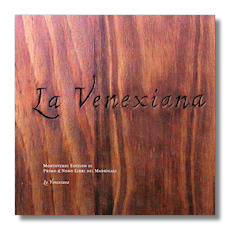
The Internet's Premier Classical Music Source
Related Links
- Monteverdi Reviews
- Latest Reviews
- More Reviews
-
By Composer
-
Collections
DVD & Blu-ray
Books
Concert Reviews
Articles/Interviews
Software
Audio
Search Amazon
Recommended Links
Site News
 CD Review
CD Review
Claudio Monteverdi

Primo & Nono Libri dei Madrigali
- First Book of Madrigals (1587)
- Ninth Book of Madrigals (1651)
Francesca Cassinari, soprano
Roberta Mameli, soprano
Nadia Ragni, soprano
Claudio Cavina, countertenor
Raffaele Giordani, tenor
Giuseppe Maletto, tenor
Matteo Bellotto, bass
Marta Graziolino, harp
Gabriele Palomba, theorbo
Anna Fontana, harpsichord
La Venexiana/Claudio Cavina
Glossa GCD920921
Until now there have been no CDs devoted to the complete First Book of Madrigals by Monteverdi. Aside from selections – on Naxos (8.555307) by Marco Longhini with Delitiæ Musicæ, and on Virgin (singly: 45143, in a seven-CD set: 562268) by Anthony Rooley and the Consort of Musicke, nothing stands out. That fact alone should make the present release on Glossa from La Venexiana with Cloudio Cavina more than welcome. Indeed it does. But not only for that: this is a splendid recording i ints own right, and can be recommended.
Monteverdi's madrigals are collected into nine books, spanning his long career in the Italian late Renaissance and early Baroque. Book One was published in 1587, when the composer was still 20; Book Nine eight years after his death in 1643. The similarities are many; the idiom of the short, concentrated essay in musical development to draw out both the essence and the tone(s) of an equally focused unit of verse. After all, it was his love of words that drove much of Monteverdi's creative impetus throughout his entire career.
So it is well that the articulation, enunciation, phrasing and projection of the three sopranos, countertenor, two tenors and bass of La Venexiana are all as clear and forward, generous and plainly communicative as they are throughout this recording. The text is audible at all times; and there is bell-like musicality without strain from start to end. La Venexiana sings with a touch of abandon, almost (listen to the end of "Se pur non mi consenti", for example, [tr.6]). Not carefree, nor careless. They just sing with a spontaneity and immediacy that is born of familiarity and affection for their material. Admirable.
This means that one can sit down and follow the development, easily study the intensity, of Monteverdi's thought uninterrupted. No effects. No fireworks. No spurious attempts to stamp any kind of personality onto the music, which it can't and ought not to bear. Expressiveness, though, is not sacrificed to clarity. Where there needs to be feeling and spirit, it's there. "Poiché del mio dolore" [tr.8], for example, while not compromising accessibility for the sonority which is sometimes emphasised in other interpretations, is full of pathos and sensitivity.
Book One is full of lively uses of language: "Ch'ami la vita mia" ("That I should love my life…"), for example, plays upon a woman's name – Camilla. But that's only the beginning: subsequent lines hint at the fact that names are being revealed/concealed. One of them can easily be seen to correspond to the Veronese aristocratic family, Verità (which means "truth", of course). There are more such plays, some of them obvious; some there for the uncovering; many lost to us now because so local and specific to the time. It takes singing of real sensitivity and self-awareness to make the most of these. La Venexiana displays all of that.
Other characteristics include contrast – of joy and melancholy; light and shade/promise and regret; of tempo and of intensity; of dramatic tension and quieter reflection. And always as the words suggest or dictate. But, from La Venexiana, never self-consciously.
So this is a most welcome addition to the catalog. The quiet (almost understated, yet unmistakable) expertise of the singers in repertoire that is as at times overpowering and spirited as Schubert's most searing Lied works so well on this recording because the performers (the entry in "Bel pastor" [tr.18] of instruments makes for additional richness, for example) are so comfortable with the idiom and seek to expose it through their deep understanding of it, rather than by deliberately lecturing us with its features. It's very natural singing, without getting carried away. Instead of breathy sighing, a wry smile on the lips (which actually only distances us from how Monteverdi felt) and an oversensitivity to the differences between how Monteverdi's listeners would have enjoyed this music and how we do, Cavina and La Venexiana easily enter right into the spirit of the music and let it convey what it was meant to convey, thanks to the musicality, rhythm and beauty of the words.
The CD is well recorded and presented; although the booklet – a little slim on detail – is set in an almost impossibly small typeface, 8pt or smaller: difficult to read! It contains the text in five languages. Nevertheless, this is a valuable and welcome addition to La Venexiana's Monteverdi Edition in particular and the availability of such wonderful music from Monteverdi's oeuvre in general.
Copyright © 2008, Mark Sealey




















